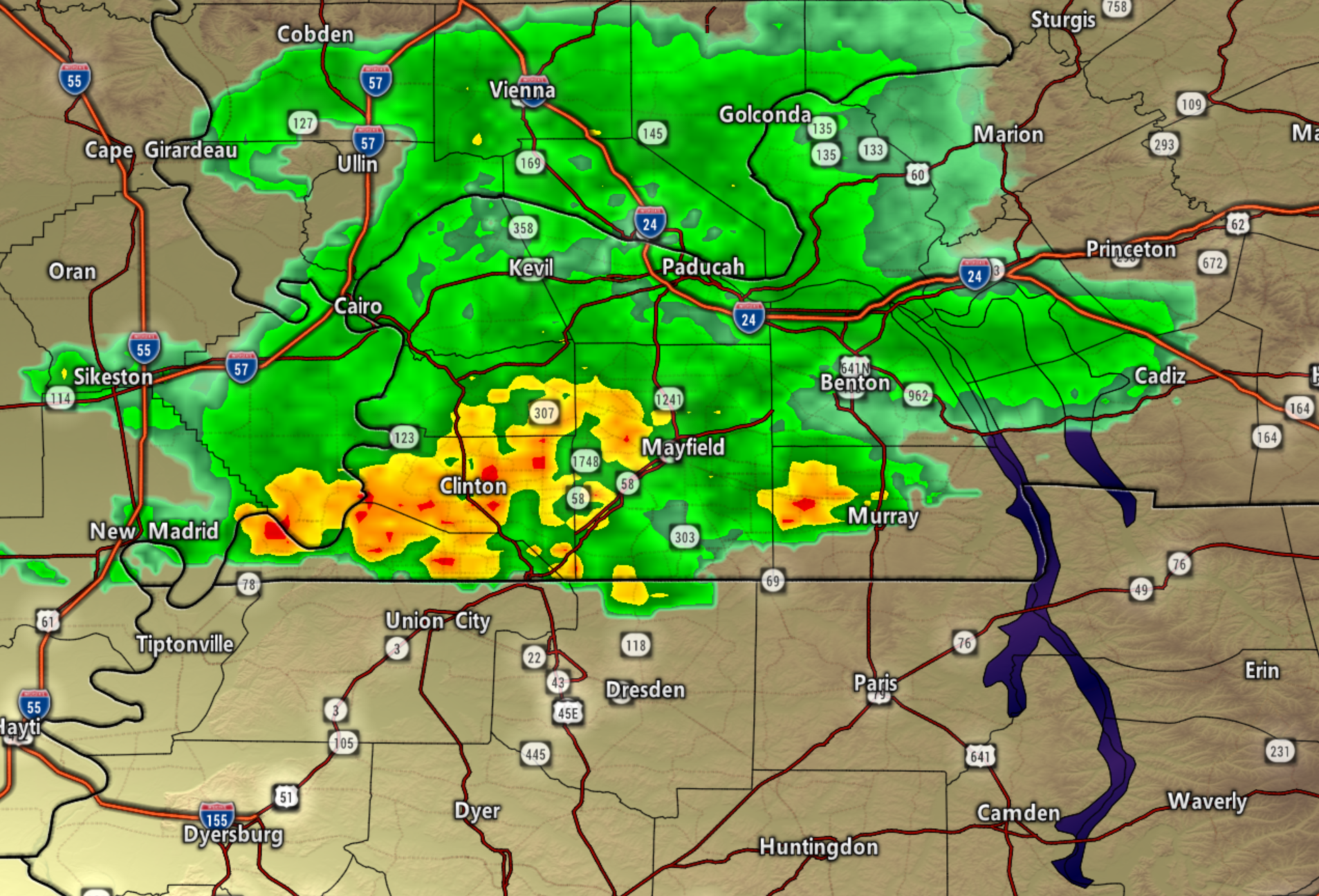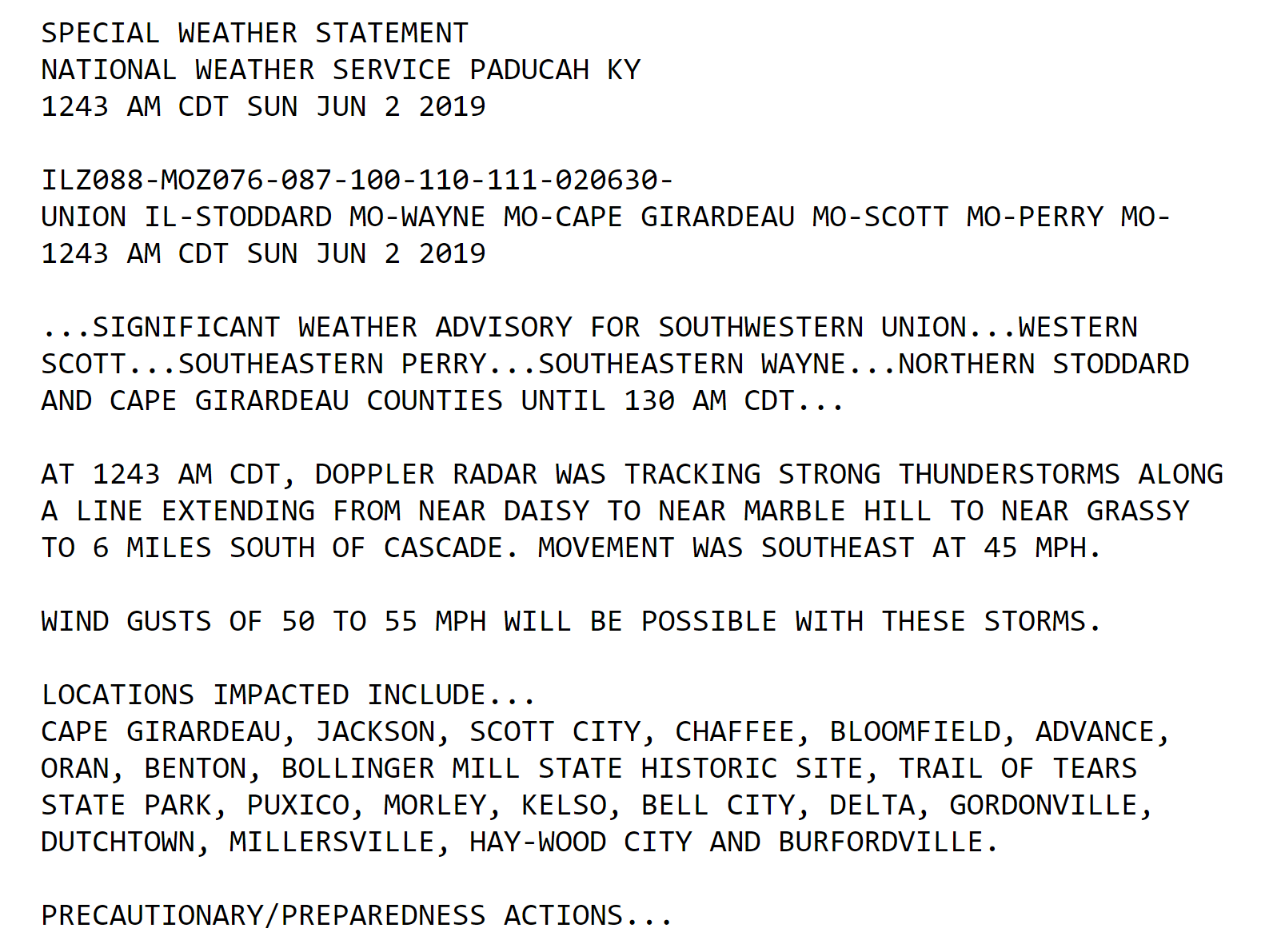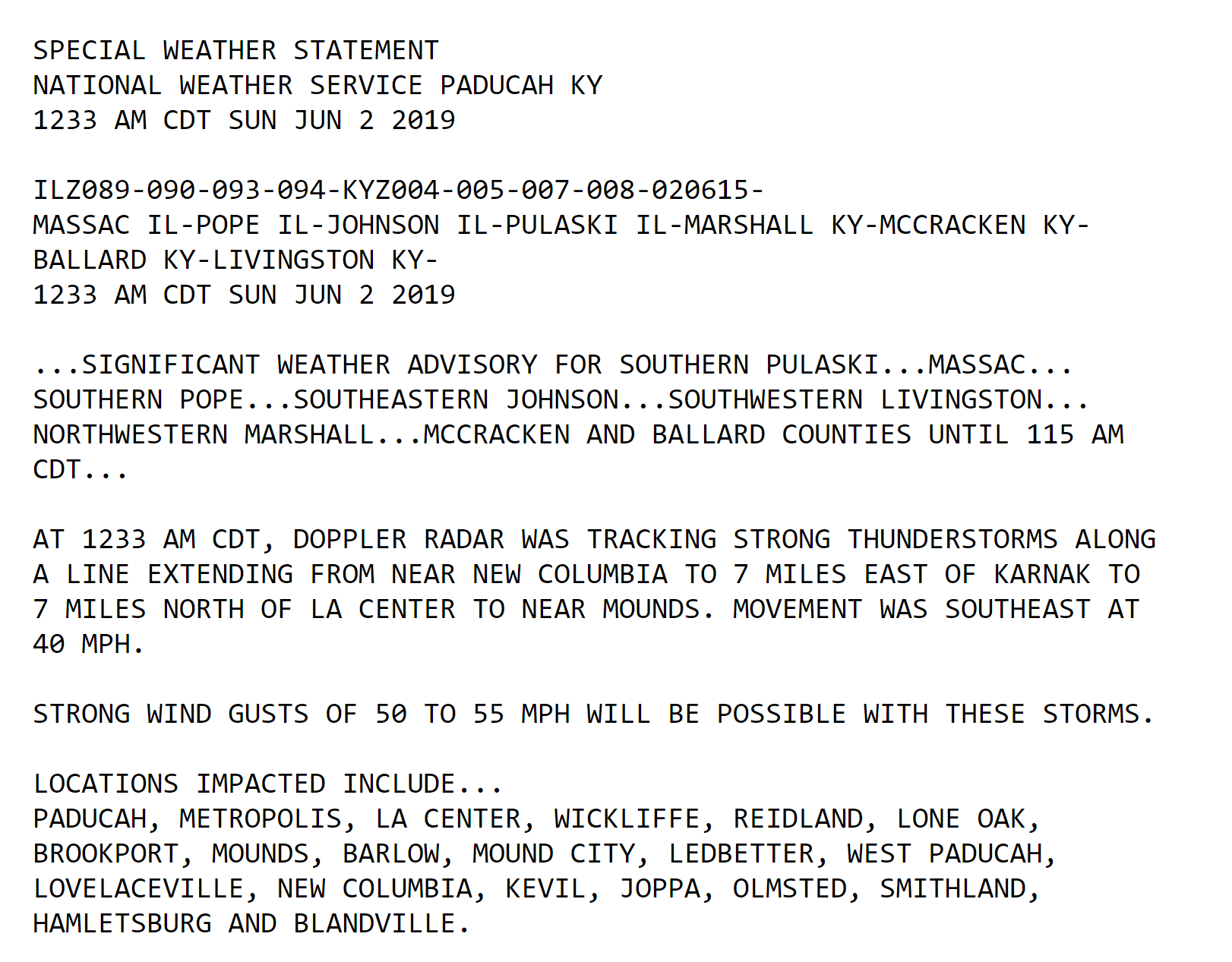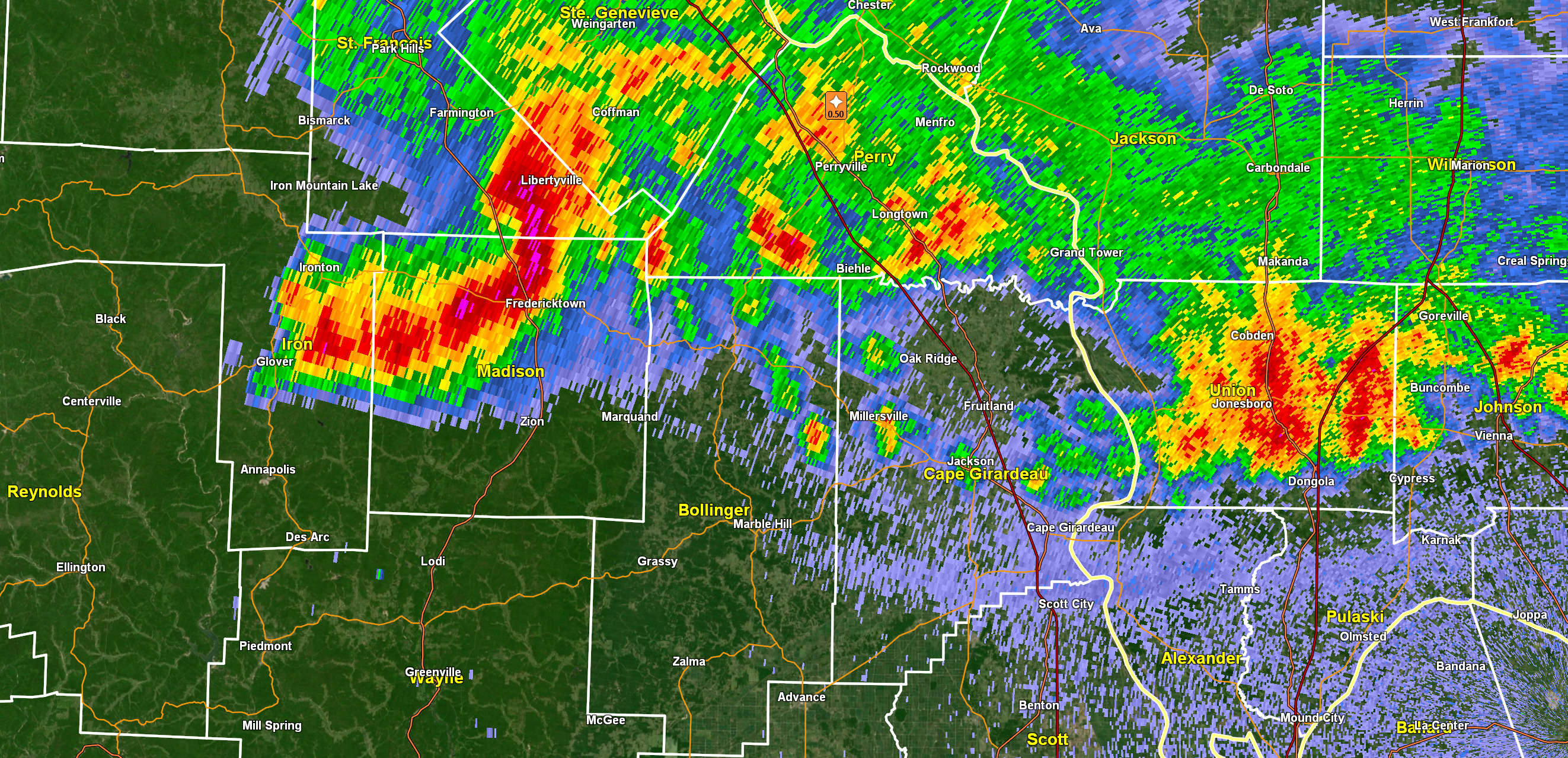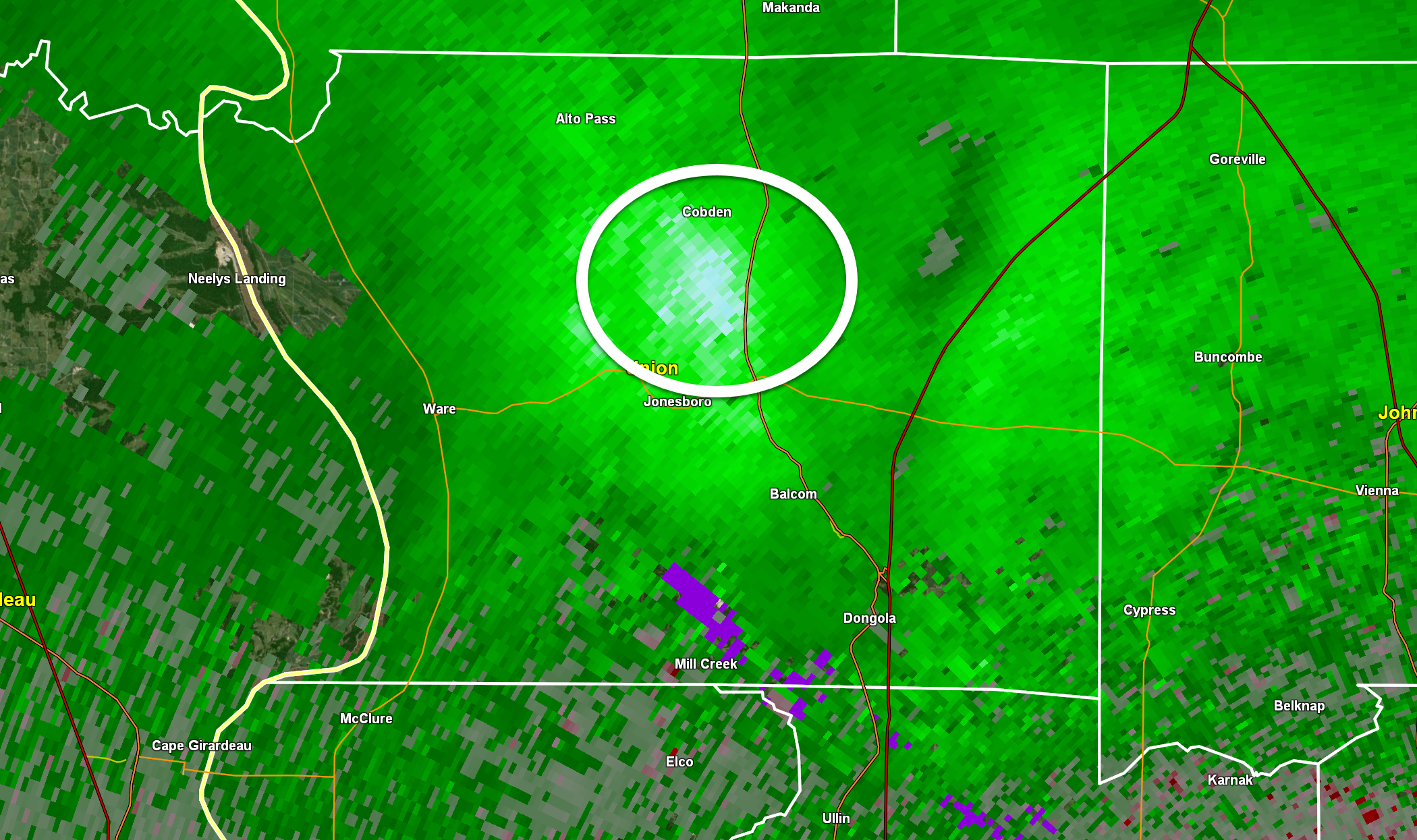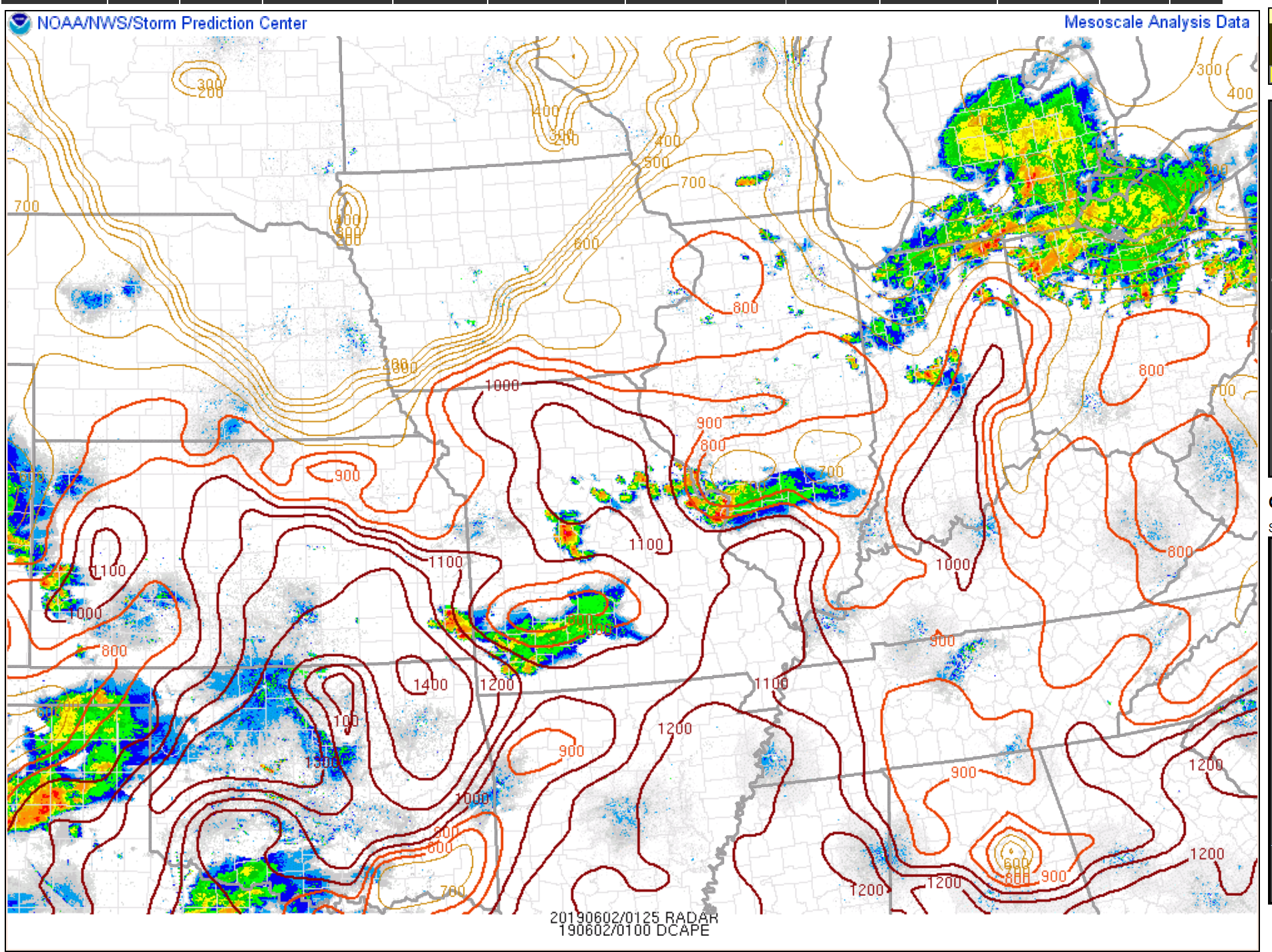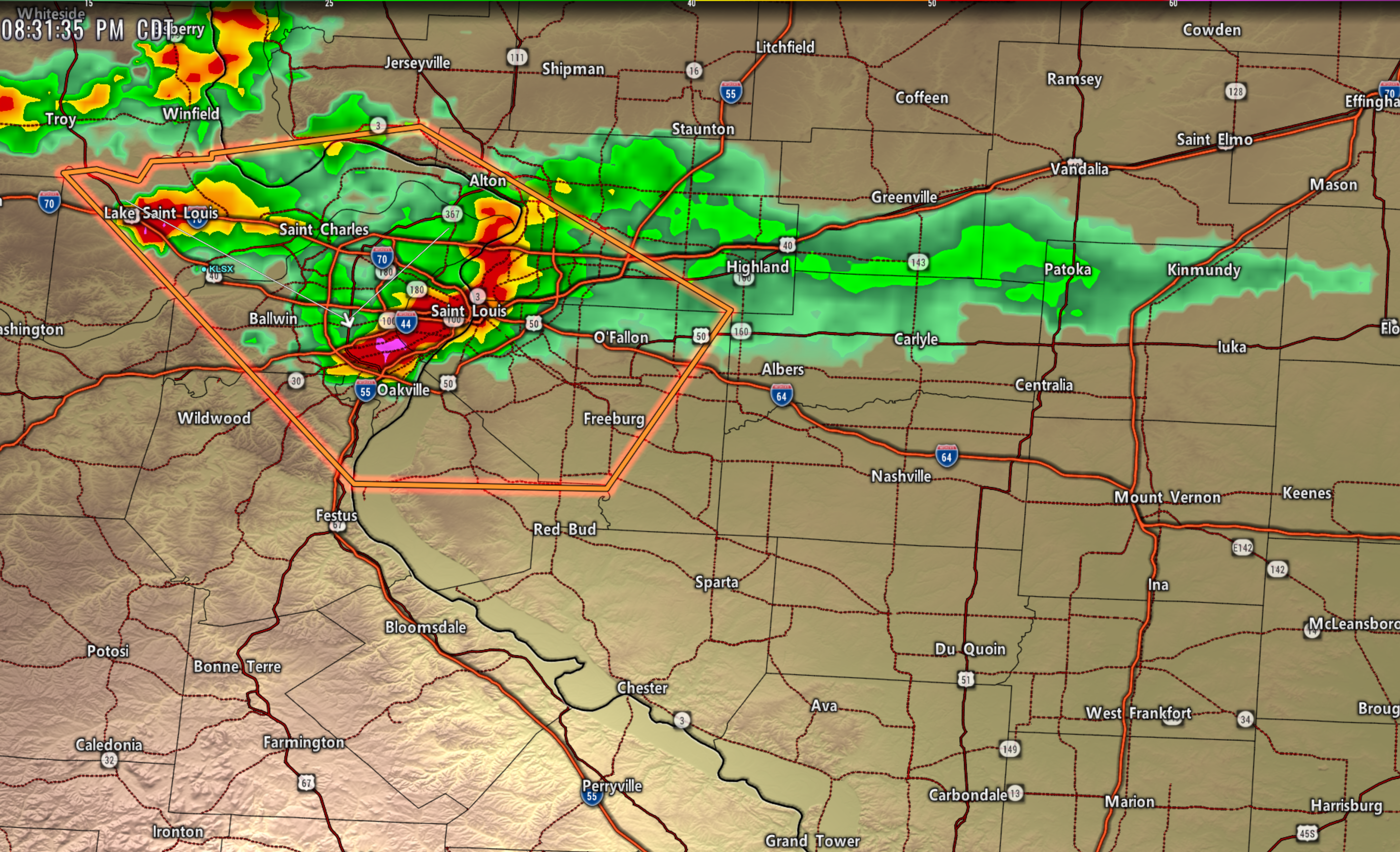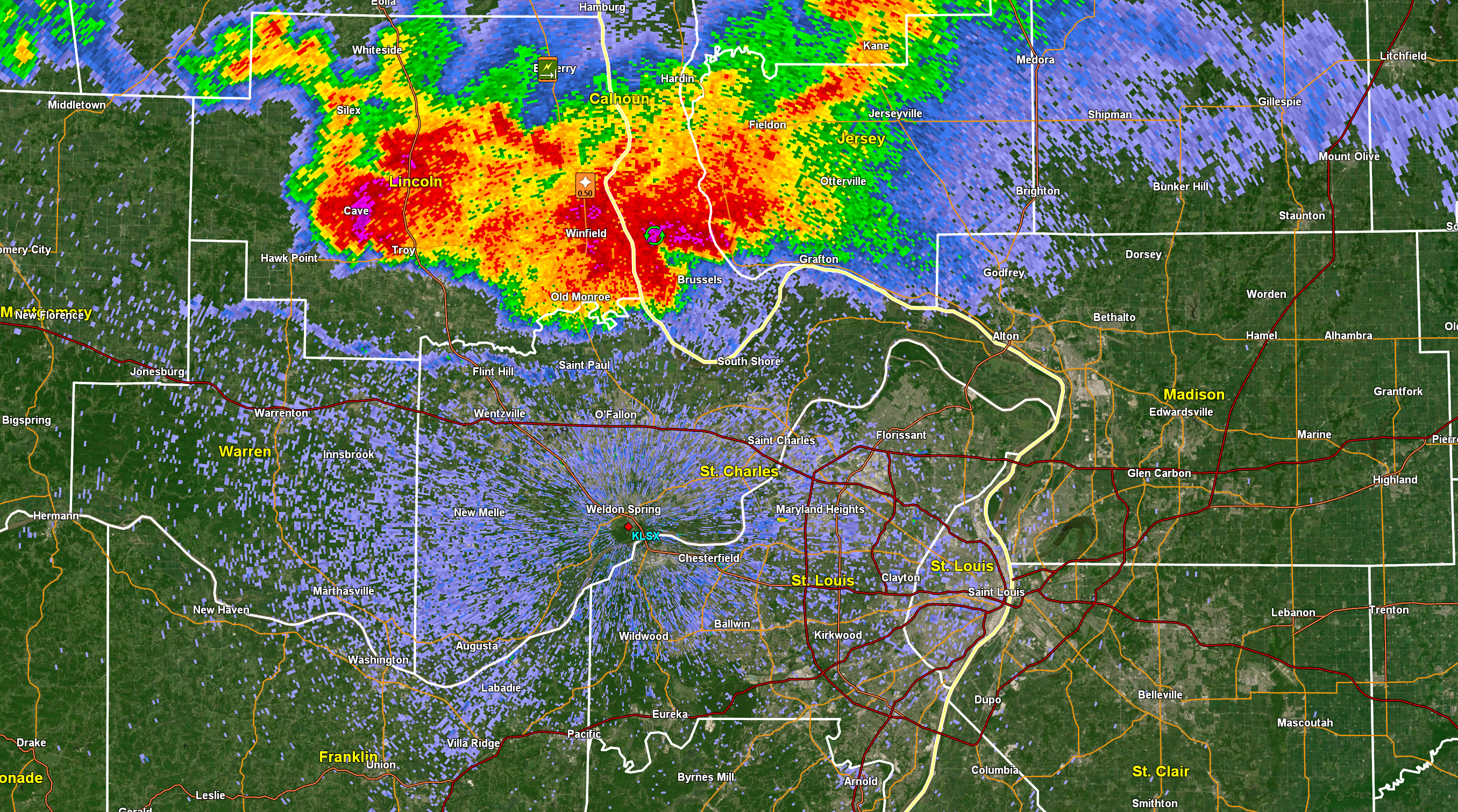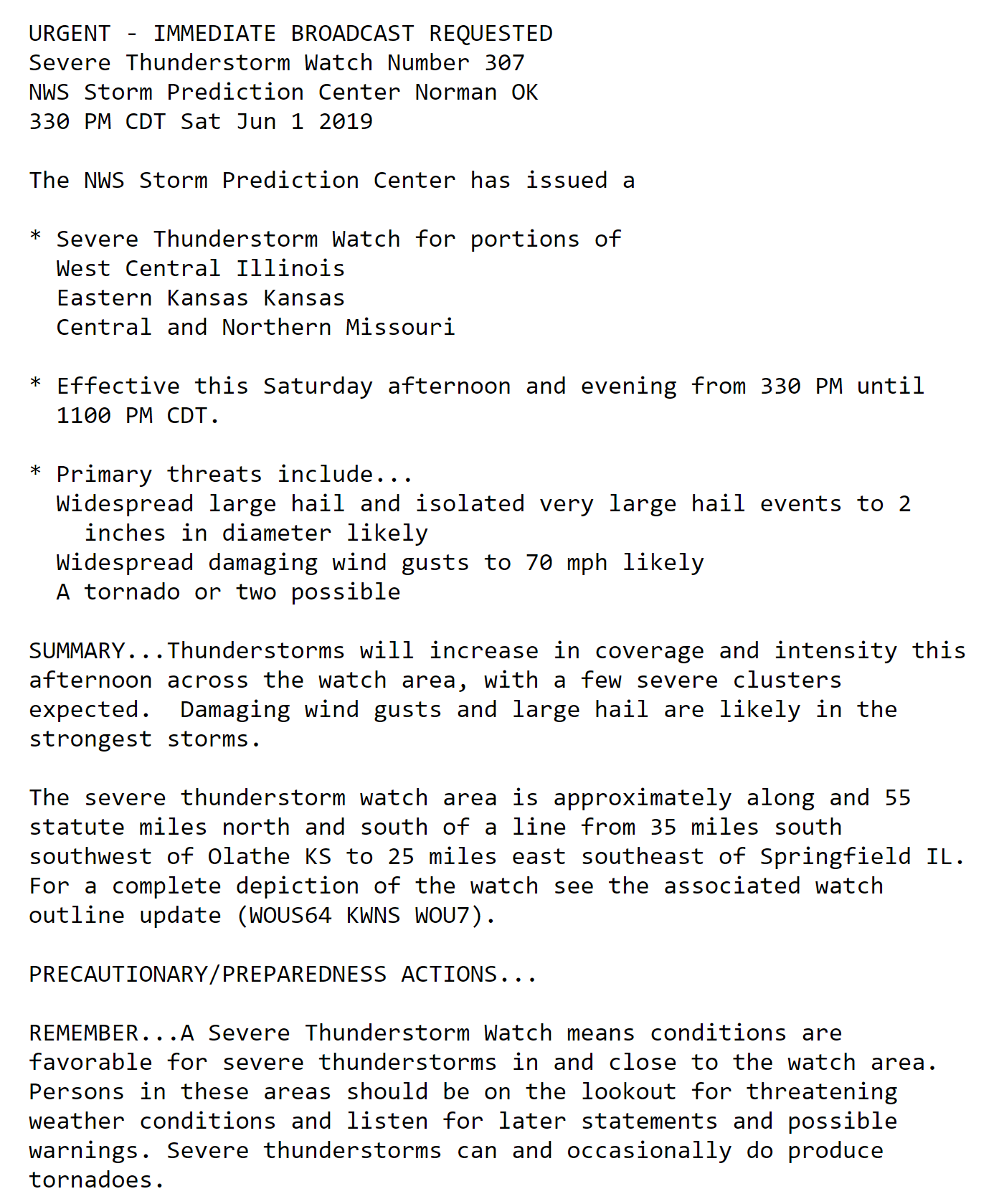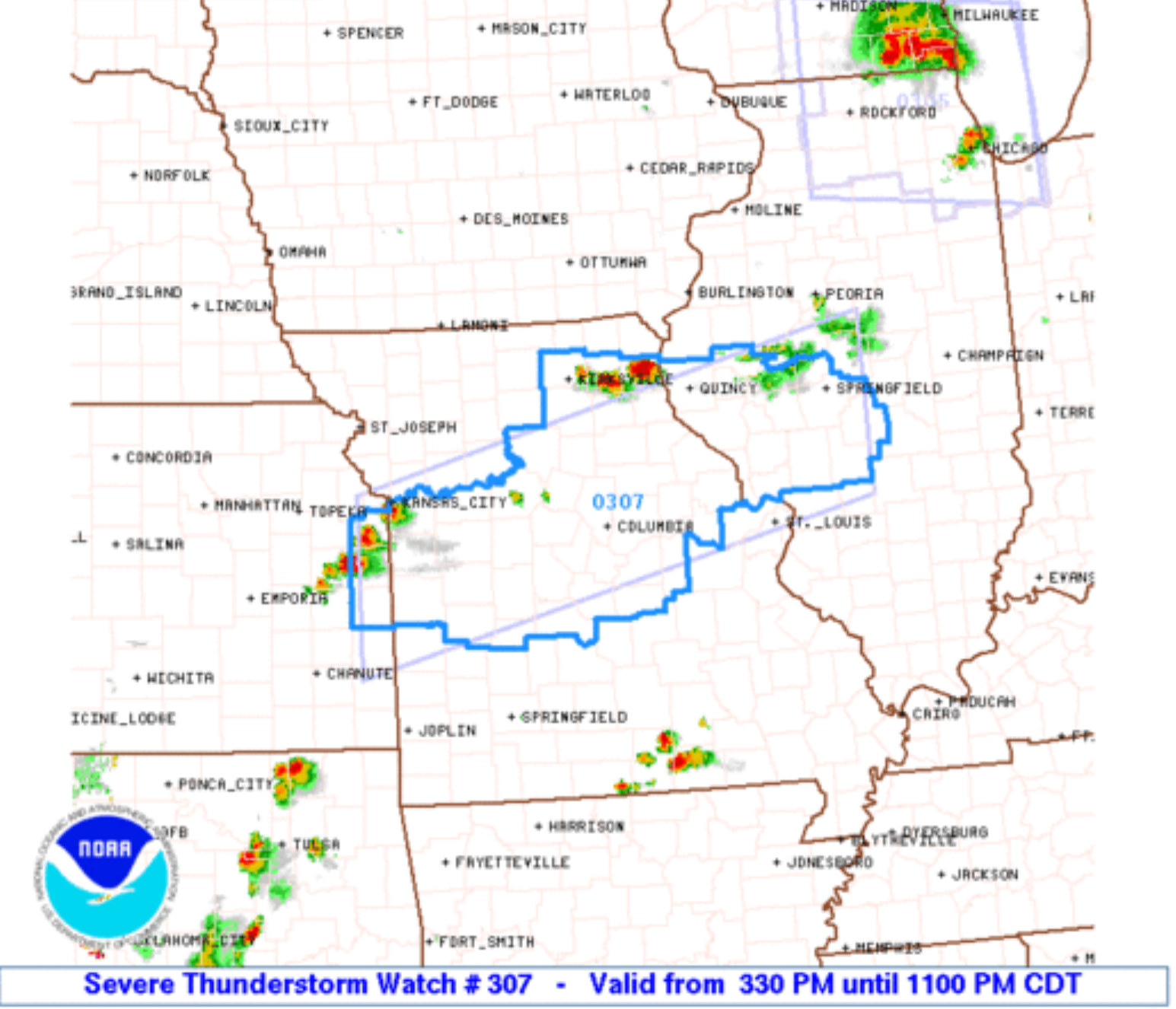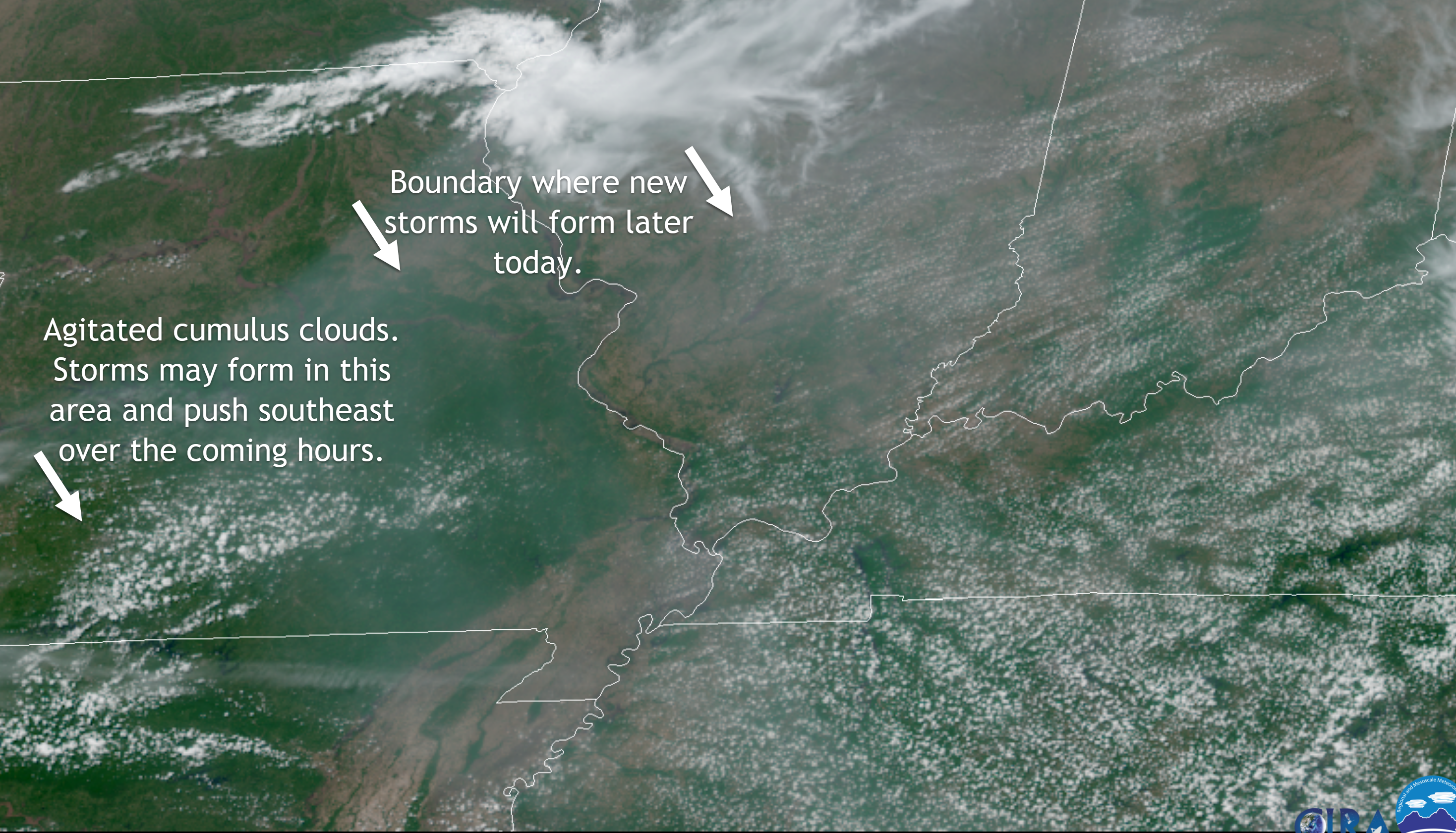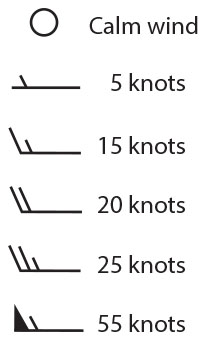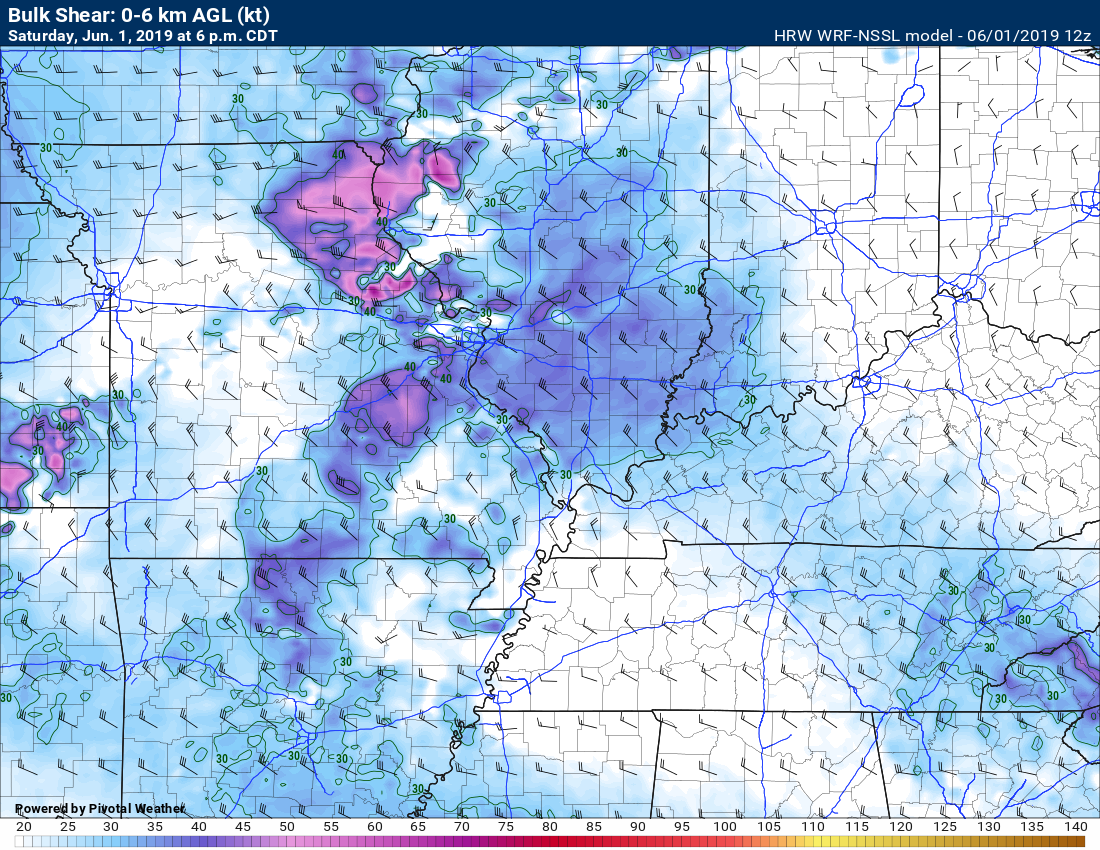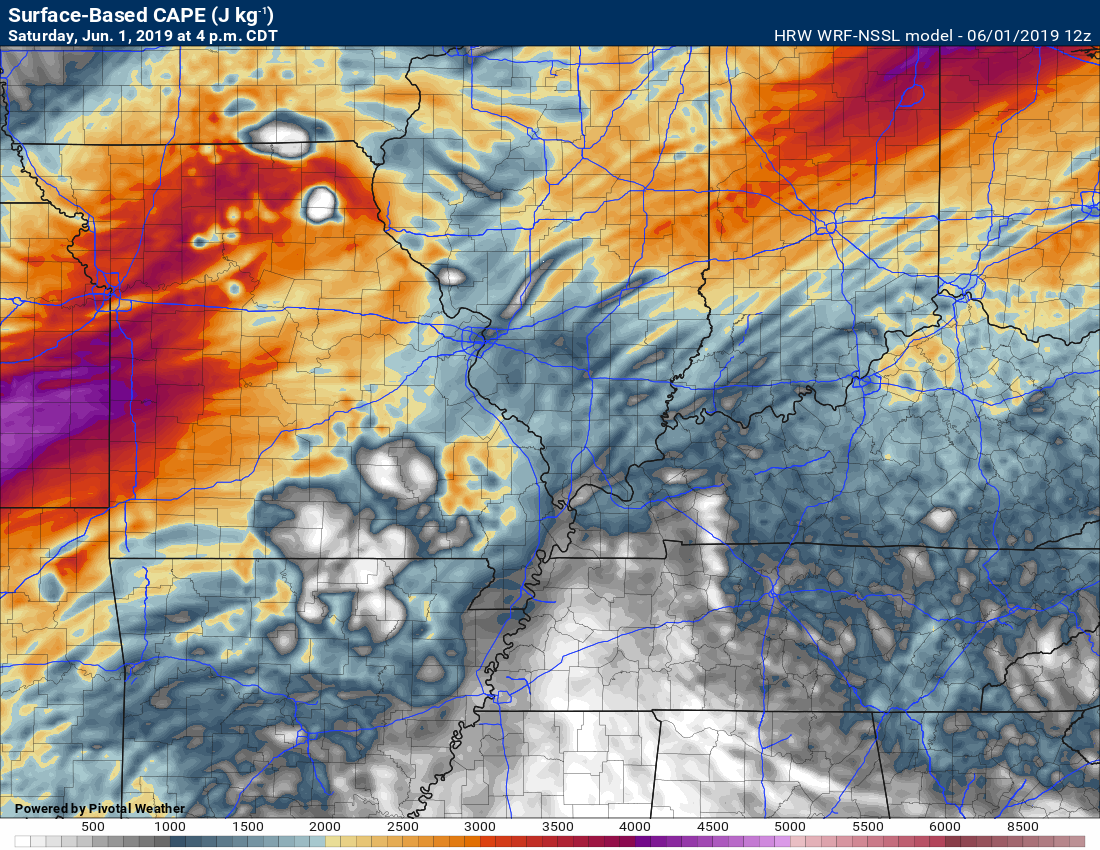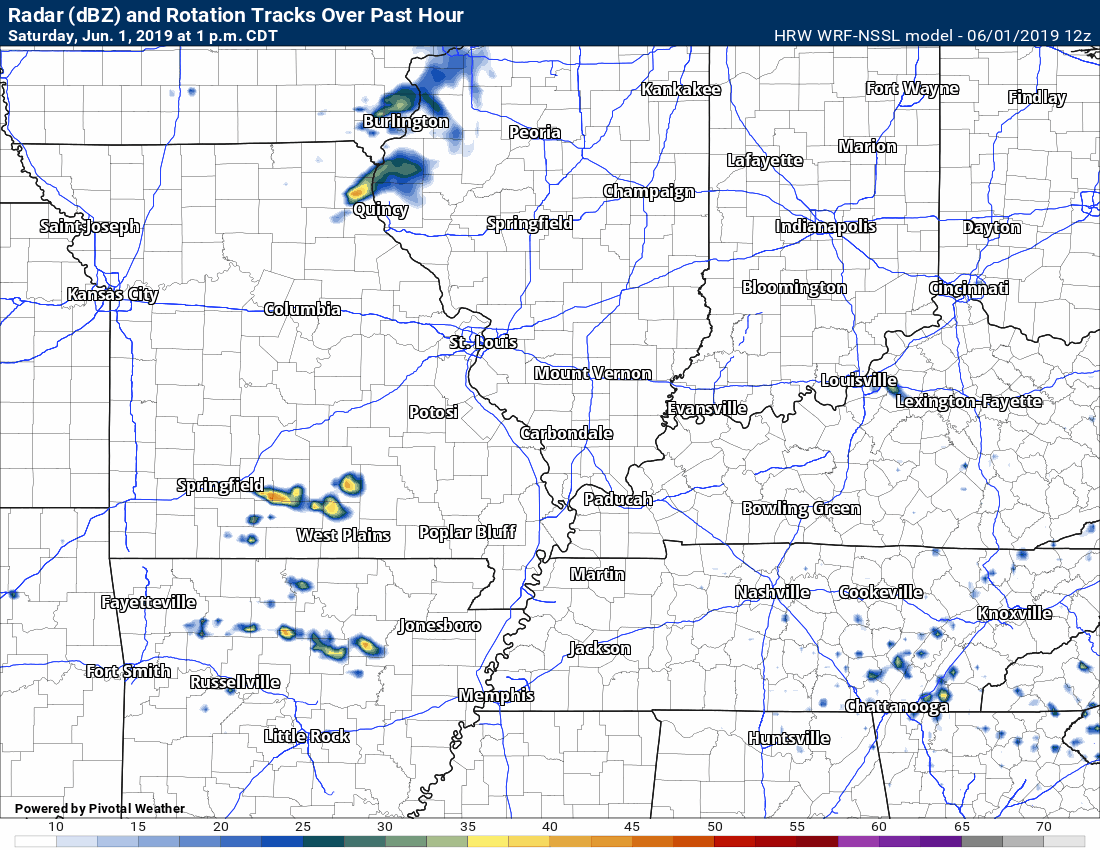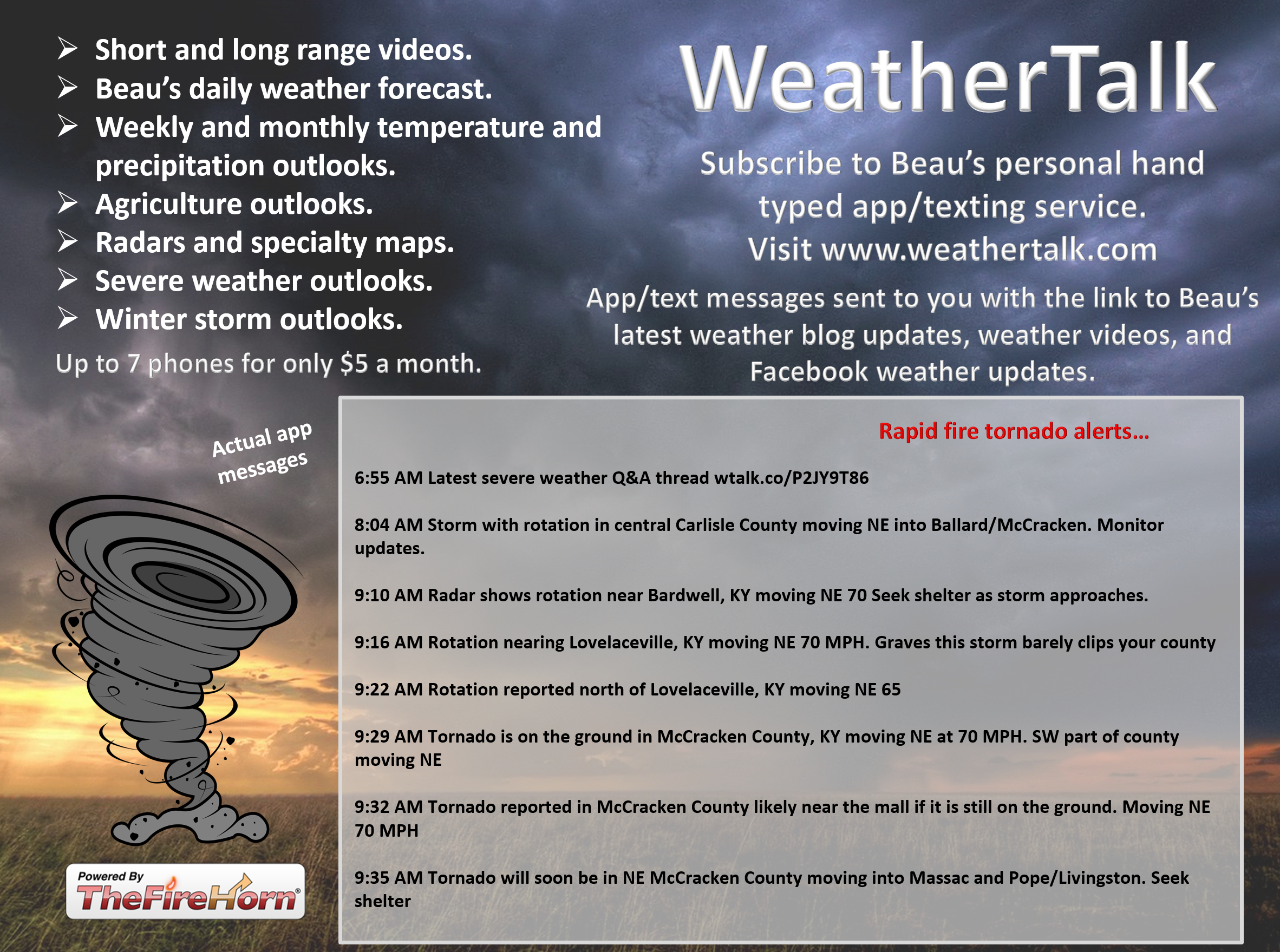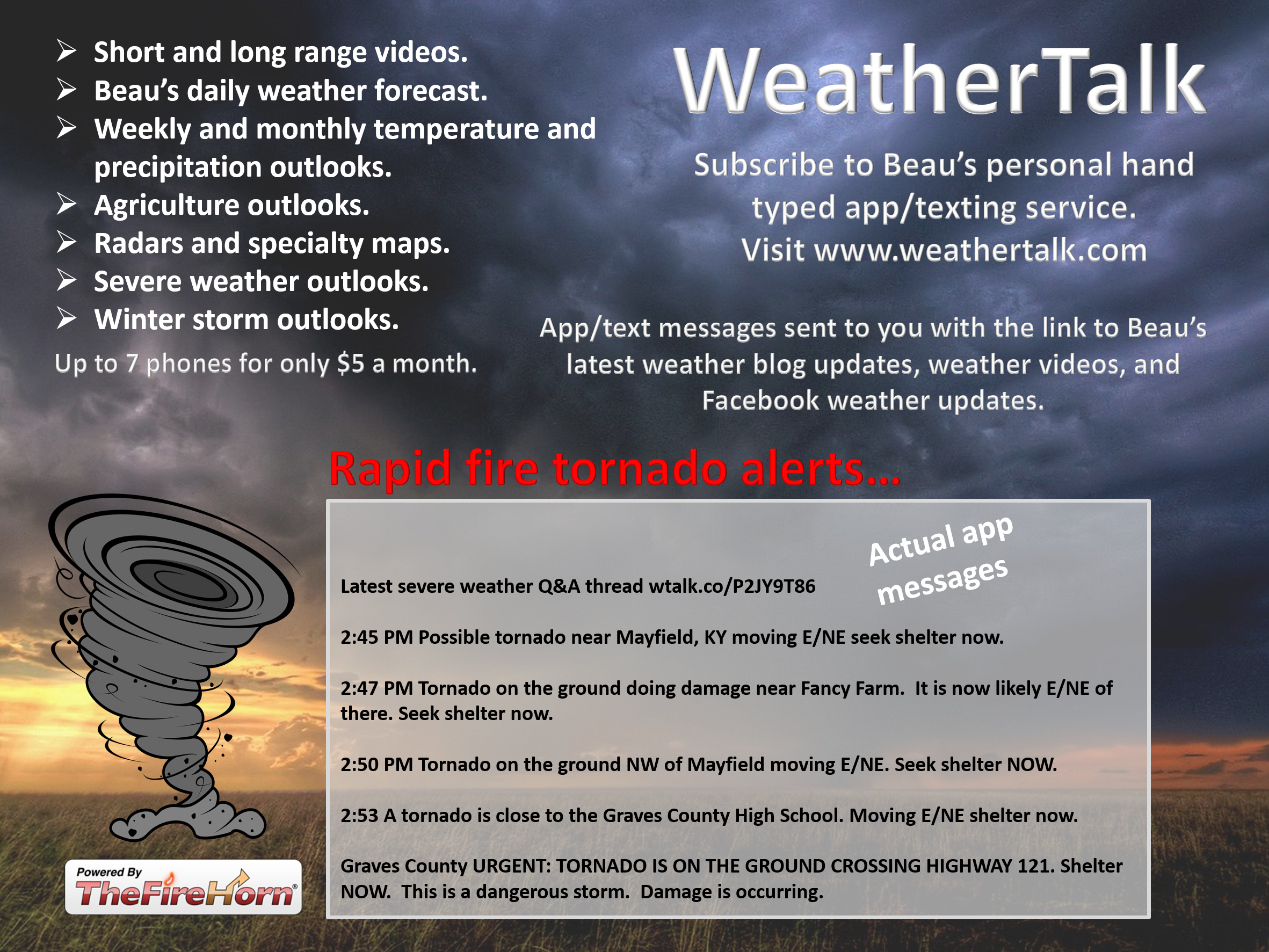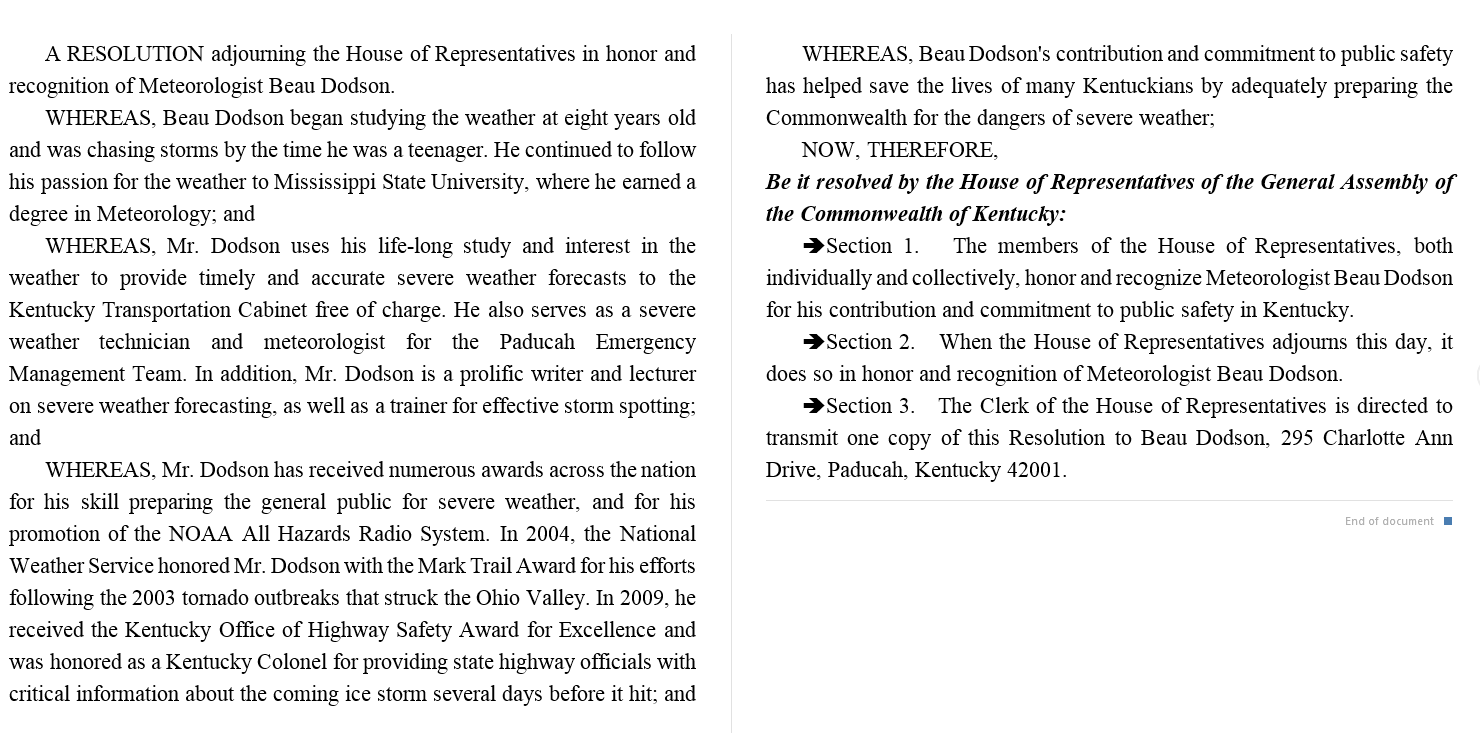I made the subscriber live severe weather live feed open to everyone today (including non-subscribers). Subscribe to the LIVE severe weather feeds (and all the other products I bring your way) at www.weathertalk.com
Activate option two in your personal notification settings (in your www.weathertalk.com account) to receive an app message when I activate the log blog.
.
BEGIN LIVE BLOG
County Maps: Click Here
FACEBOOK Q&A LINK
INSERT LINK HERE
Live-interactive radars: Click here
Regional radar link: Click here
Live lightning data: Click here.
Go to all of the storm tracking tools. Radars, lightning, & satellite.
.
I have a busy day ahead. I am going to go ahead and start the severe weather live blog. We likely won’t have any concerns until late afternoon into the evening hours. The further north you drive the better the odds of problems.
.
2:25 AM
Much of the region is not finished with storms for the night.
Storms will continue into the Missouri Bootheel, along the Kentucky/Tennessee border, and into western Tennessee.
There are rain showers north of the main thunderstorm band. You can still have lightning with those.
The bulk of the rain will exit the region over the coming two to three hours.
Only a slight chance of thunderstorms tomorrow. Less than 10% chance. We do have to watch this time of the year. It does not take much to pop a storm or two. Summer pattern.
Update on the latest radar trends.
Storms continue to march their way southward. They are moving south at about 40 mph.
Heavy rain, lightning show, gusty winds, and dime size hail possible.
Isolated winds of 50 mph possible.
Live radar link
http://weatherobservatory.com/radar_paducah.htm
.
12:49 AM
Storm in NW McCracken County is weakening a bit.
I am not seeing the wind max there.
I had wind gusts into the 40s at my place. Radar showed higher to my west.
.
12:44 AM
A significant weather advisory is issued for storms that are not severe. They are a step below severe levels.
Severe means 60 mph winds and/or quarter size hail (and tornadoes, of course).
.
.
12:38 AM
Western Massac and NW McCracken. A storm with the possibility of damaging wind was located NW of Joppa moving S SE at 40 mph.
.
12:37 AM
A significant weather advisory is issued for storms that are not severe. They are a step below severe levels.
Severe means 60 mph winds and/or quarter size hail (and tornadoes, of course).
.
12:32 AM
Bollinger County, MO. Storm with a line of damaging wind NW of Marble Hill. The line is moving SE at 40 mph.
.
12:31 AM
Bollinger County storm may have damaging winds. The bow continues to move S/SE at 30 mph. Nickel size hail, as well.
.
12:07 AM
The storm entering Bollinger County is now bowing outward. This could mean high winds.
Live-interactive radars: Click here
Click to enlarge
.
12:00 AM
Union County, IL. Radar indicates damaging winds near or south of Cobden. The storm is moving south at 30 mph.
You can see the bright blues on this radar image. Some of those winds may be reaching the ground.
This storm is behind the outflow boundary. It has shown higher wind speeds over the past ten minutes.
.
.
11:58 PM
11:52 PM
11:16 PM
Storms are pushing through parts of southeast Missouri and southern Illinois. The storms are producing dime size hail, 45 mph wind gusts, frequent lightning, and heavy rain.
The overall severe weather risk is small. Storms have been weakening over the past hour.
Cloud tops have come down a bit. That is one thing I look for when storms are weakening.
With that said, they are strong. I can’t rule out quarter size hail and 50 to 55 mph wind gusts in isolated locations.
I won’t send an app message out unless severe weather develops.
.
9:42 PM
St. Genevieve County in Missouri and Randolph and Perry Counties in southern Illinois. They could still produce high winds and some hail. Be aware.
.
8:51 PM
St. Genevieve County in Missouri and Randolph and Perry Counties in southern Illinois. Be aware that occasionally these type of bowing storm lines can produce short-lived tornadoes with little or no warning. Just be aware.
.
8:49 PM
The storms have a history of pea to half dollar size hail. Numerous reports of dime size.
Affton [St. Louis Co, MO] trained spotter reports HAIL of golf ball size (M1.75 INCH) at 08:30 PM CDT
.
8:30 PM
Mesoanalysis.
The atmosphere over southeast Missouri and southern Illinois is unstable. Wind shear is around 30 knots.
The storms will continue to move south and southeast. Some of the storms will produce strong winds and hail. The tornado risk is low, but not zero. Sometimes QLCS tornadoes can quickly spin up in thunderstorms. QLCS tornadoes are not the same as supercell tornadoes. QLCS tornadoes tend to last seconds to minutes.
They can destroy a home. A tornado is a tornado.
Be alert as the storms continue to push into our area.
The storms will weaken as we lose the daytime heating.
I do not believe the storms will remain severe all the way into extreme southern Illinois and western Kentucky.
With that said, monitor updates. Sometimes these storms can form a cold pool behind them. That helps to accelerate them and can enhance the wind damage threat.
DCAPE is fairly high. DCAPE is a product that I monitor when considering downburst winds. As the storms collapse they could produce localized damaging wind gusts.
That would be more likely from Perry County, Missouri east/northeast towards Franklin County in southern Illinois.
Also, notice that PWAT values are moderate to high. Notice the sharp difference from southwest Illinois to southeast Illinois.
PWAT is a measure of moisture in the atmosphere. I monitor it to determine how heavy the rain could be.
These numbers aren’t extreme. They are sufficient to help produce torrential downpours in the thunderstorms.
Thankfully, storms are moving along.
DCAPE
Click images to enlarge them.
PWAT values.
.
8:27 PM
St. Genevieve County in Missouri and Randolph and Perry Counties in southern Illinois. Be aware, I am tracking St Louis storms moving S SE. They have a history of quarter size hail and wind damage. Arrival time between 9:15 and 10:00 pm.
Live radar -> Local radar – click here.
The orange box is a severe thunderstorm warning.
.
7:22 PM
A bow echo is forming north of St Louis, MO. It is moving due south.
70+ mph winds are possible. A tornado is possible.
I am monitoring my northern counties as these storms approach.
Here it is on the radar. Please see the local interactive radar to help you track its position.
Click on the image below to enlarge it.
.
4:00 PM
Our first watch of the day. A bit too our northwest. These are the storms of concern.
Storms are still way north of my forecast area.
Radar
See live radar links above.
.
Click text and images to enlarge.
.
1:30 PM
10:00 AM, Saturday, June 1, 2019
First, check out this morning’s GOES 16 satellite.
Two items of interest. The thick smoke in the air. You can see it. Second, the lack of clouds.
More sunshine equals higher temperatures. That equals higher CAPE values. Think of CAPE as energy for storms to tap into.
The new GOES 16 satellite is simply amazing.
Notice the storms in Iowa? That is the part of the system that will produce storms in our region later today and tonight.
.
Click images to enlarge them.
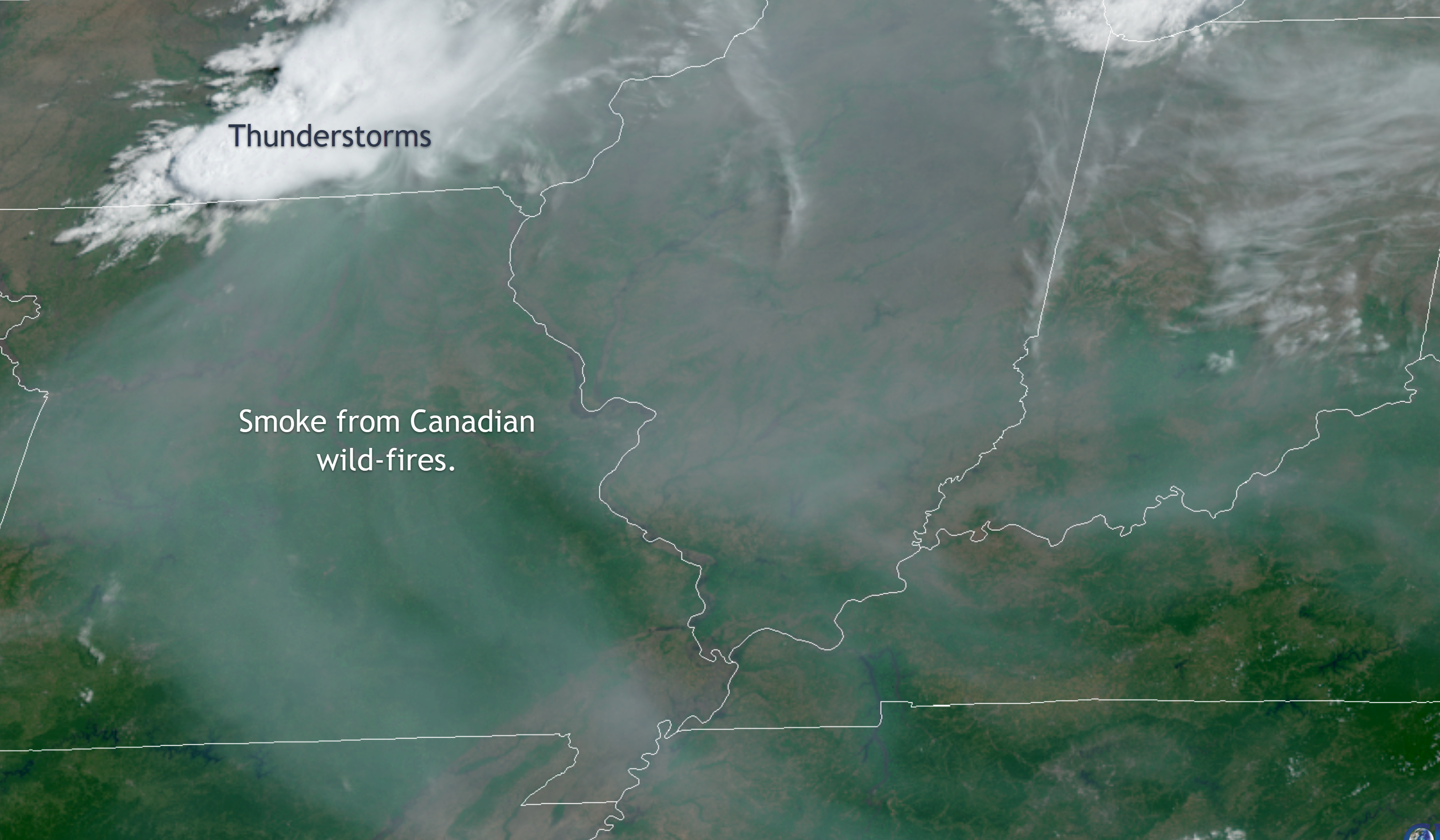
.
Go about your business this morning and early afternoon. I do not have any immediate concerns. The concerns will increase, across portions of the region, later today.
Let’s take a look at the Storm Prediction Centers severe weather outlook.
The black outline is our local area.
Light green is where thunderstorms may occur but should be below severe levels.
Dark green is a level one risk. Yellow is a level two risk. Orange is a level three (enhanced) risk. Red is a level four (moderate) risk. Pink is a level five (high) risk.
One is the lowest risk. Five is the highest risk.
Light green is not assigned a number. Light green is where storms may occur but should be below severe levels.
A severe storm is one that produces 60 mph winds or higher, quarter size hail, and/or a tornado. One or more of those is defined as a severe thunderstorm.

.
Severe thunderstorms are possible later today. Two rounds of storms may impact the region. The first will arrive during the 12 PM to 4 PM time-frame over the Missouri Ozarks. Some of these may impact my far western counties (Bollinger and Butler). These storms could produce isolated hail and high winds. Lightning is a concern for those outdoors. Locally heavy rain, as well.
The rest of the area should remain rain-free through 4 PM.
Late this afternoon and evening, supercell thunderstorms should develop over northern and central Missouri and northern and central Illinois. These supercell storms will produce half-dollar-size hail, 65+ mph wind gusts, and isolated tornadoes.
There are questions about how far south the thunderstorms will travel.
The best upper air support for severe weather will be pulling away as these storms push into our central and southern counties. Central and southern counties would be along and south of a line from Bollinger and Cape Girardeau counties in southeast Missouri, eastward through Johnson and Pope Counties of southern Illinois, and then northeast towards southern Indiana.
Areas south of that line will need to monitor updates. If the storms do survive they will likely be in a weakening state.
Now, with all of that said, the atmosphere will be unstable today. There is some wind shear for thunderstorms to utilize. Wind shear is one ingredient when forecasting severe weather. CAPE (energy for storms) will likely range from 1000 to 2500. That is sufficient for severe thunderstorms.
Click images to enlarge them.
Notice the wind barbs. Northwest to the southeast. The wind flow today will mean that storms will move south and southeast. They will approach our region from the St Louis area (not including the Ozark activity).
In meteorology, we use wind barbs to denote wind direction and speed.
CAPE values
.
Dew points will be in the 60s. Dew point is a measure of moisture. I generally look for 58 degrees and above when considering a severe weather outlook.
Click image to enlarge.
.
The main concern for our region will be quarter size hail (perhaps a bit larger over our far northern counties), damaging wind gusts, and perhaps a short-lived tornado or two. Overall, the tornado risk is not high. It also is not zero. It is late May and early June. This is our peak time of the year for severe thunderstorms. Thus, monitor updates.
Let’s take a look at some future-cast radars. These are fresh of the printing press.
Now, keep in mind, these are model projections of what radar might look like later today. That does not mean they will be correct.
I do believe they have the right idea.
NAM 3K model
Click on the animations to enlarge them.
SPC WRF model
.
I will be monitoring radars as we move through the day. I will post updates every few hours until storms form or become severe. Check back regularly and hit the refresh button. The latest information is at the top of the page.
The video team posted this severe weather outlook for the Ohio Valley.
.
Not receiving app/text messages?
Make sure you have the correct app/text options turned on. Find those under the personal notification settings tab at www.weathertalk.com. Red is off. Green is on.
Subscribers, PLEASE USE THE APP. ATT and Verizon are not reliable during severe weather. They are delaying text messages.
The app is under Beau Dodson Weather in the app store.
Apple users click here
Android users click here
.
.
* The Missouri Bootheel includes Dunklin, New Madrid, and Pemiscot Counties
* Northwest Kentucky includes Daviess, Henderson, McLean Union, and Webster Counties
County Maps: Click Here
.
I made the severe weather live blog free for everyone today.
If you are not a subsriber then please consider becoming one.
.
WeatherTalk monthly operating costs can top $4000.00. Your $5 subscription helps pay for those costs. I work for you.
The $5 will allow you to register up to seven phones!
For $5 a month you can receive the following. You may choose to receive these via your WeatherTalk app or regular text messaging.
Severe weather app/text alerts from my keyboard to your app/cell phone. These are hand typed messages from me to you. During tornado outbreaks, you will receive numerous app/text messages telling you exactly where the tornado is located.
.
- Daily forecast app/texts from my computer to your app/cell phone.
- Social media links sent directly to your app/cell phone. When I update the blog, videos, or Facebook you will receive the link.
- AWARE emails. These emails keep you well ahead of the storm. They give you several days of lead time before significant weather events.
- Direct access to Beau via text and email. Your very own personal meteorologist. I work for you!
- Missouri and Ohio Valley centered video updates
- Long-range weather videos
- Week one, two, three and four temperature and precipitation outlooks.
Monthly outlooks. - Your subscription also will help support several local charities.
.
Would you like to subscribe? Subscribe at WWW.WEATHERTALK.COM
.
.
Today’s outlook (below).
Light green is where thunderstorms may occur but should be below severe levels.
Dark green is a level one risk. Yellow is a level two risk. Orange is a level three (enhanced) risk. Red is a level four (moderate) risk. Pink is a level five (high) risk.
One is the lowest risk. Five is the highest risk.
Light green is not assigned a number. Light green is where storms may occur but should be below severe levels.
A severe storm is one that produces 60 mph winds or higher, quarter size hail, and/or a tornado. One or more of those is defined as a severe thunderstorm.

The black outline is our local area.

.
Tomorrow’s outlook.
Light green is where thunderstorms may occur but should be below severe levels.
Dark green is a level one risk. Yellow is a level two risk. Orange is a level three (enhanced) risk. Red is a level four (moderate) risk. Pink is a level five (high) risk.
One is the lowest risk. Five is the highest risk. Light green is not assigned a number.


.
Be sure and have WeatherOne turned on in your WeatherTalk accounts. That is the one for tornadoes, severe storms, and winter storms.
Log into your www.weathertalk.com
Click the personal notification settings tab.
Turn on WeatherOne. Green is on. Red is off.
.

Here is the latest graphic from the WPC/NOAA.
.
24-hour precipitation outlook.
.

.
48-hour precipitation outlook.
.
.
.
72-hour precipitation outlook.
.

.
Days one through seven added together. Seven-day rainfall totals.

.

Radar Link: Interactive local city-view radars & regional radars.
You will find clickable warning and advisory buttons on the local city-view radars.
If the radar is not updating then try another one. If a radar does not appear to be refreshing then hit Ctrl F5. You may also try restarting your browser.
Not working? Email me at beaudodson@usawx.com
National map of weather watches and warnings. Click here.
Storm Prediction Center. Click here.
Weather Prediction Center. Click here.
.

Live lightning data: Click here.
.

Interactive GOES R satellite. Track clouds. Click here.
GOES 16 slider tool. Click here.
College of Dupage satellites. Click here
.

Here are the latest local river stage forecast numbers Click Here.
Here are the latest lake stage forecast numbers for Kentucky Lake and Lake Barkley Click Here.
.
Did you know that you can find me on Twitter? Click here to view my Twitter weather account.
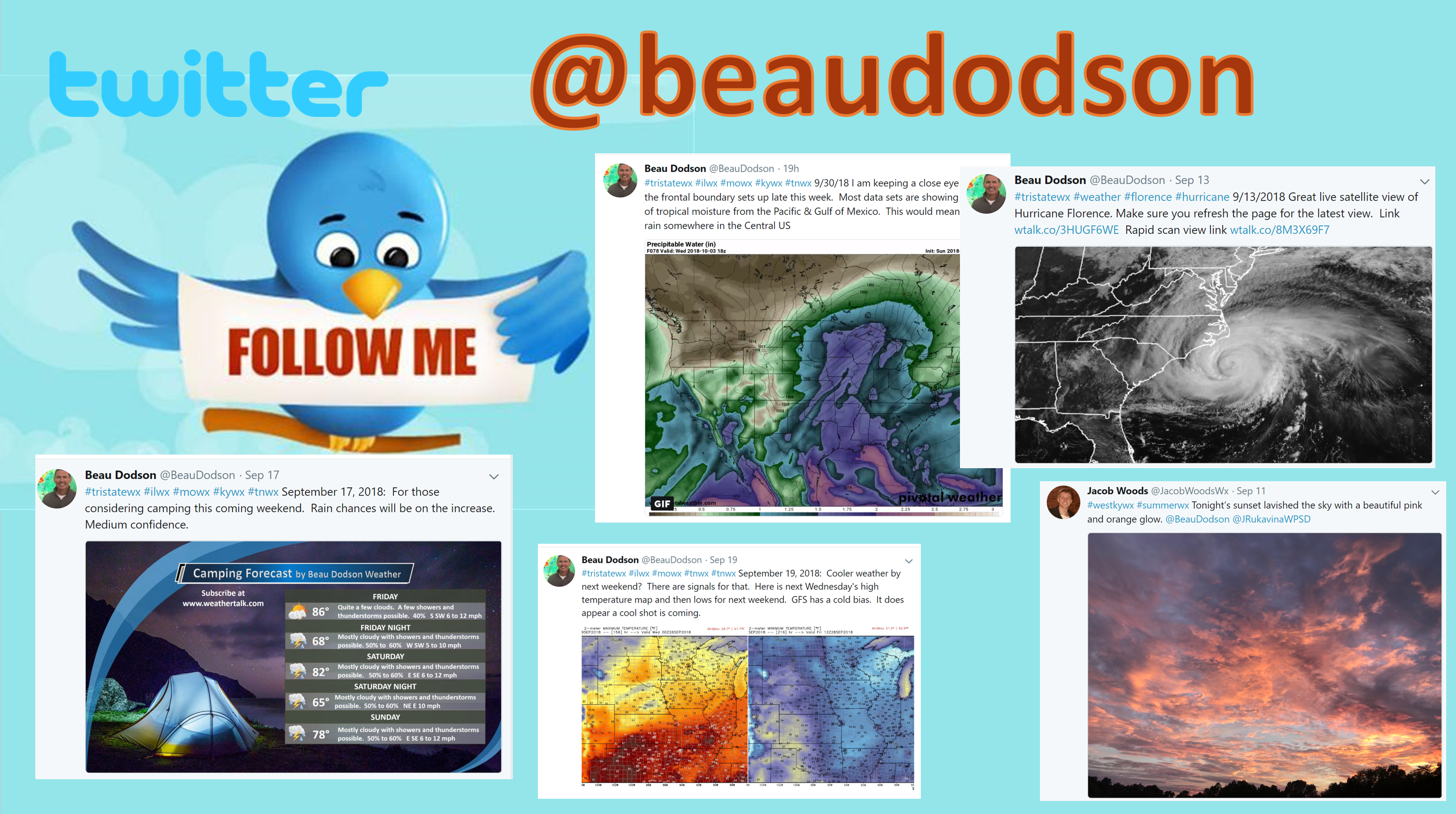
.

.
Who do you trust for your weather information and who holds them accountable?
I have studied the weather in our region since the late 1970s. I have 40 years of experience in observing our regions weather patterns.
My degree is in Broadcast Meteorology from Mississippi State University and a Bachelor of Science (BS).
I am an NOAA Weather-Ready Nation Ambassador. I am the Meteorologist for McCracken County rescue squad. When asked, I assist Ballard and Massac Counties, as well.
I own and operate the Southern Illinois Weather Observatory and WeatherTalk LLC.
There is a lot of noise on the internet. Over time you should learn who to trust for your weather information.
My forecast philosophy is simple and straight forward.
- Communicate in simple terms
- To be as accurate as possible within a reasonable time frame before an event
- Interact with you on Twitter, Facebook, and the blog
- Minimize the “hype” that you might see on television or through other weather sources
- Push you towards utilizing wall-to-wall LOCAL TV coverage during severe weather events
I am a recipient of the Mark Trail Award, WPSD Six Who Make A Difference Award, Kentucky Colonel, and the Caesar J. Fiamma” Award from the American Red Cross.
In 2009 I was presented with the Kentucky Office of Highway Safety Award.
I was recognized by the Kentucky House of Representatives for my service to the State of Kentucky leading up to several winter storms and severe weather outbreaks.
If you click on the image below you can read the Kentucky House of Representatives Resolution.

WeatherBrains Episode 696
.
Tonight’s show features no guests – tonight’s show mainly focuses on the severe weather event of May 20th across the Plains States as well as discussing the accompanying “High Risk” issued by the Storm Prediction Center.Other discussions in this weekly podcast include topics like:
- How does the general public react to a “High Risk”?
- The forecasting and leading up to 5/20/19 severe weather event
- The dangers of hype and comparing different major severe weather events
- Suptropical Storm Andrea forms in western Atlantic
- Heavy snow in Colorado and higher elevations of Northern California
- National Weather Round-Up
- The Astronomy Report from Tony Rice
- and more!
.
.
Previous episodes can be viewed by clicking here.
.
Find Beau on Facebook! Click the banner.

.
Find Beau on Twitter! Share your weather photos! @beaudodson

.
Click here to go to the top of the page
Did you know that a portion of your monthly subscription helps support local charity projects? Not a subscriber? Becoming one at www.weathertalk.com
You can learn more about those projects by visiting the Shadow Angel Foundation website and the Beau Dodson News website.


